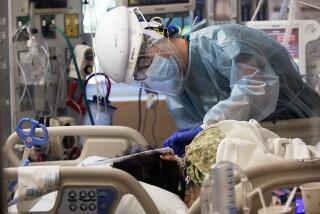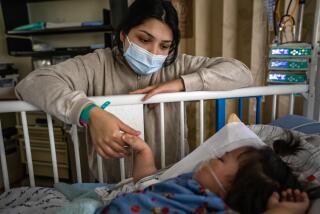Hospitals Turn to Task of Protecting Staffs From AIDS
When Mary Owen became the nurse epidemiologist at Martin Luther Hospital in Anaheim in 1979, most hospitals were primarily concerned that doctors and nurses might carelessly infect their patients with harmful bacteria.
But because of the current fear of AIDS, she says, many hospitals have put new emphasis on protecting doctors and nurses against patients infected with the deadly disease.
Because of the nature of the AIDS virus, which has delayed symptoms and sometimes isn’t evident in patients, precautions to protect medical workers are being instituted throughout hospitals, whereas in the past they were limited to isolation wards, she said.
To allay staff fears and to comply with a recent directive from the Centers for Disease Control in Atlanta, Owen said, hospitals throughout the nation are regarding all patients as potentially infectious and devising hospital-wide plans to protect health workers.
In Orange County, she said, representatives of 30 hospitals who are members of the Orange County chapter of the Assn. for Practitioners have been meeting since August to compare plans and try to set a standard.
Most county hospitals, she said, are moving in the same direction as Martin Luther, which has taken several steps in recent months to position itself on the defensive in the war on acquired immune deficiency syndrome:
- The hospital installed 200 glove dispensers, one in each patient room, to protect nurses who draw blood from patients or otherwise come in touch with other body fluids that can transmit AIDS.
- Containers with slots similar to mailboxes were mounted in each patient’s room. The hospital staff deposits needles and syringes in these receptacles after they are used to draw blood or administer drugs. The hope is that this new procedure will reduce the frequency of nurses accidentally pricking themselves with contaminated needles.
- Next month, the hospital will station in patient rooms and critical care areas a batch of newly purchased resuscitation masks. The masks are designed to allow a nurse to blow into a patient’s mouth while preventing air exhaled from the patient from entering the nurse’s mouth. The masks also contain a filter to prevent any exchange of saliva between patient and nurse.
- Under a new hospital policy, emergency room nurses no longer wear uniforms that they launder at home. Instead, they change from street clothes into scrub gowns that the hospital sends to a commercial laundry. And all linen in the hospital emergency room that is soiled with the body fluids of patients is now automatically considered “contaminated” and thrown into special bags to be disinfected.
Hospital supervisors say that the staff, which normally resists changes in protocol, is eagerly using the new equipment, including extra goggles, gloves and gowns, that have been purchased for their protection.
Elaine Holiday, director of emergency services at the hospital, said wearing gloves has become a high priority in that department and elsewhere in the hospital. “In the past if a patient was bleeding, you used to grab a compress and now you grab gloves and then a compress,” she said.
More surgical crews at Martin Luther have begun wearing goggles to protect their eyes from being splashed by blood during operations, while nurses in the labor and delivery department are wearing new surgical gowns designed to give more protection against blood seepage. And doctors are more often requesting blood tests to determine if patients on whom they expect to operate are carrying the AIDS virus, Owen said. The number of orders jumped to 86 tests in June through November, compared to 33 in the preceding six months.
Owen said surgeons more often are ordering tests for drug addicts, homosexuals and other patients thought to be high AIDS risks, especially those scheduled for elective surgery who can wait for laboratory results and maternity patients who will expose nurses and doctors to considerable blood in the delivery room.
Jack Petrona, manager of the hospital’s clinical laboratory, said he has bought the laboratory coats, goggles and special needle holders to give his staff a greater sense of confidence in handling blood and other specimens.
He said he has told his staff to alert him to any “new gadget” that will help. “Anything to keep the people from getting panicked over the whole situation,” he said.
In reality, Owen said Martin Luther has treated relatively few diagnosed AIDS patients--six in the past two years.
But she said Anaheim has the third-highest incidence of AIDS in Orange County, after Laguna Beach and Santa Ana, and Martin Luther is preparing for a larger AIDS caseload in the future based on the projections of government agencies.
By extrapolating from national projections of the Centers for Disease Control, Penny Weismuller, AIDS coordinator for Orange County Public Health, figures that by January, 1991, the county will have 965 residents with AIDS, compared to the current 589.
More to Read
Sign up for Essential California
The most important California stories and recommendations in your inbox every morning.
You may occasionally receive promotional content from the Los Angeles Times.










